Day 2 of a two day Private Tour in North Norfolk. It was a very different day to yesterday. Heavy rain overnight thankfully cleared through early, but it was much cooler, grey and cloudy, with some showers through the morning. After the Wader Spectacular yesterday, we would spend the day today looking for Autumn migrants and other interesting birds along the coast.
After our failure to even get in the (still partly closed) car park yesterday, we headed over to Titchwell first. There was no problem with parking today – it helped being early, but the weather had an effect too, with many fewer beachgoers clogging it up all day. It was nice that people could actually get in and do some birdwatching today!
The rain had stopped by the time we arrived, so we had a quick look round the overflow car park before it got busy. There was very little at first, until we got right round to the far corner, where we found several Blackcaps feeding in the elders, along with Blackbirds and a Song Thrush.
We headed straight out onto the reserve. We had just got onto the main path, beyond the Visitor Centre, and turned to scan the grazing meadow through the gap in the trees. A very distant Common Buzzard was perched on top of a bush over towards Thornham, but a white dot on the brambles below caught our eye. We were not even sure it was a bird at that range, but we set up the scope to look just in case. A shrike!
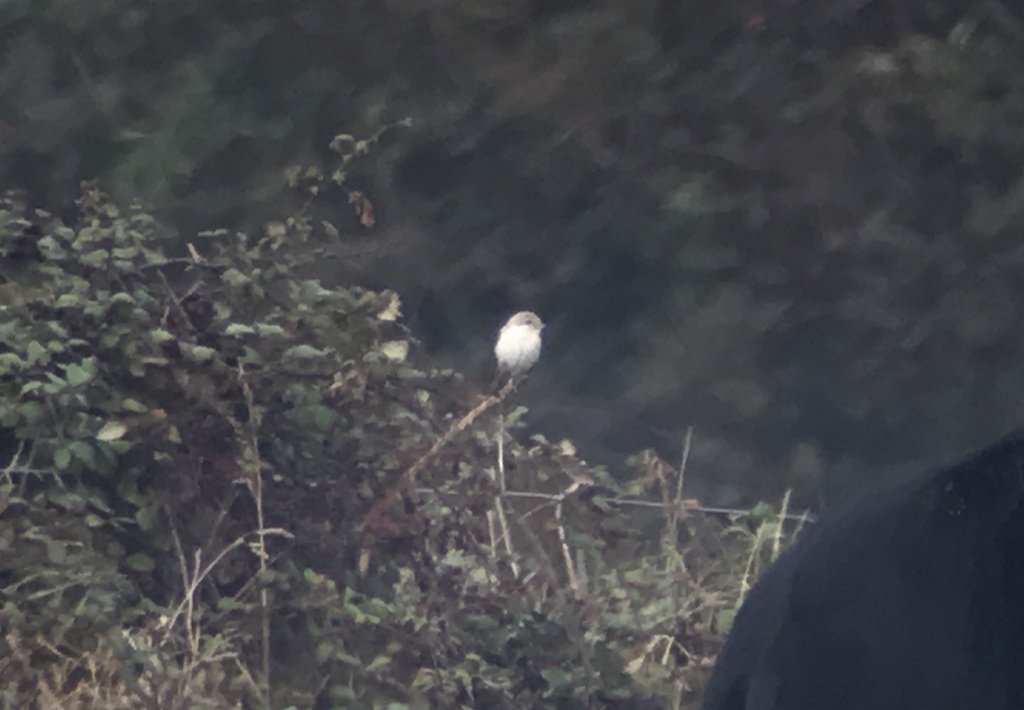
The shrike looked rather pale-headed at first, perched face on to us, but after a while it dropped down to the ground and came back up to the same bush with its back to us. We could see a bit more of it now and it looked good for a young (1st winter) Red-backed Shrike. Another good find, our second in four days. We let everyone at the Visitor Centre know, and a few of the staff came out for a look.
As we continued on along path, we came across a flock of Long-tailed Tits in the tall willows. We stopped to look through them, just in case, but all we could find today were a couple of Chiffchaffs with them. As we came out of the trees, a Greenshank came up off the dried up pool on Thornham grazing marsh and flew past us, disappeared round the back of the trees behind us.
A quick look out at Reedbed Pool produced a few Common Pochard out on the water, an addition to the trip wildfowl list. A young Hobby was hunting distantly over the back of the reedbed and up over Willow Wood beyond.
It was a still morning and we had just said it might be good for Bearded Tits when we heard their pinging calls ahead of us. A flock of about eight of them flew up and landed again in the reeds quite close to the main path. We walked up and stood opposite where they had landed. After a few seconds they started to climbed up into the tops of the reeds to feed on the seedheads. We had fantastic views, several males with powder grey heads and black moustaches accompanied by a few grey-brown females.
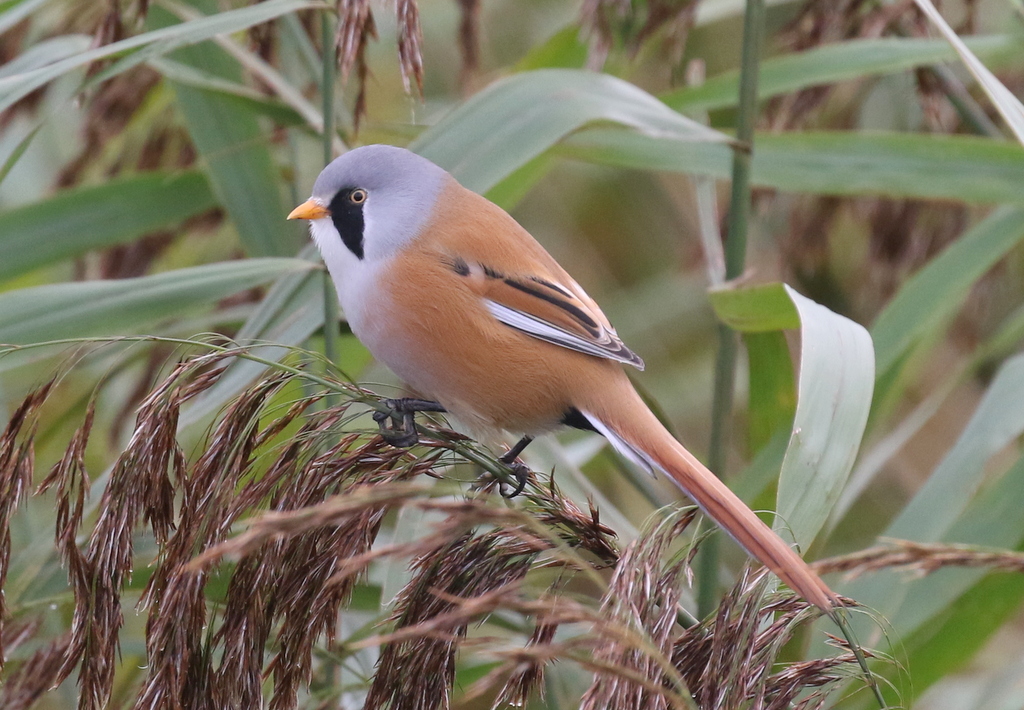
A Great White Egret flew out of the reedbed and landed briefly on the Freshmarsh while we were watching the Bearded Tits. Then it flew again and came straight towards us, before turning and flying across the path just in front of us. It was another great view – we could see its long, dagger-like yellow bill, long trailing black legs, and deep slow wingbeats. We watched as it headed out over the saltmarsh the other side.
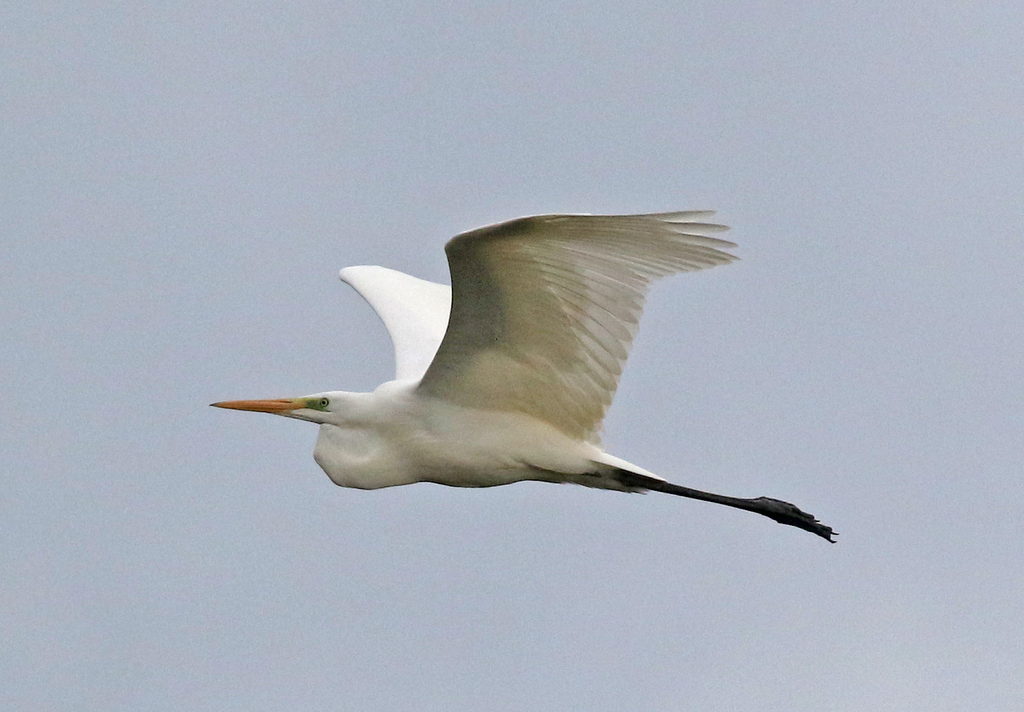
There were more Bearded Tits in the reeds up by Island Hide – it was certainly a great morning for them. We had a quick look at the Freshmarsh, where we could see a couple of Spoonbills out in the middle, and a large gathering of godwits, including a good number of Bar-tailed Godwits come in to roost over high tide.
Our key target for the morning was to see if we could find any Lapland Buntings out on the beach. More people were arriving on the reserve now, and we were worried that they might get flushed again, so we decided to head straight out to Thornham Point, before it got too busy. We could come back to look at the Freshmarsh at our leisure later.
It was high tide, and the Volunteer Marsh was pretty much completely covered in water. A small group of Common Redshank had gathered on one of the sandy islands at the back of the Tidal Pool. One bird was standing separate from them, in the water, and instantly looked paler. A Spotted Redshank, we could see its long, needle-fine bill and prominent white supercilium.

A line of birds roosting on the spit a little further up included several Grey Plovers, a couple of them still with their summer black bellies, plus a few Knot, Turnstones, Bar-tailed Godwits and Oystercatchers. They had all come in here from the beach to roost over high tide.
Out onto the beach, we turned left and headed out towards Thornham Point. A Snow Bunting flew in with a small group of Sanderling and landed on the edge of the water ahead of us. It ran up the sand and we watched it picking around on the high tide line. We walked past slowly, so as not to spook it, but we needn’t have worried. It was very tame, as they often are, and allowed us past just a few metres away, unconcerned by our presence.
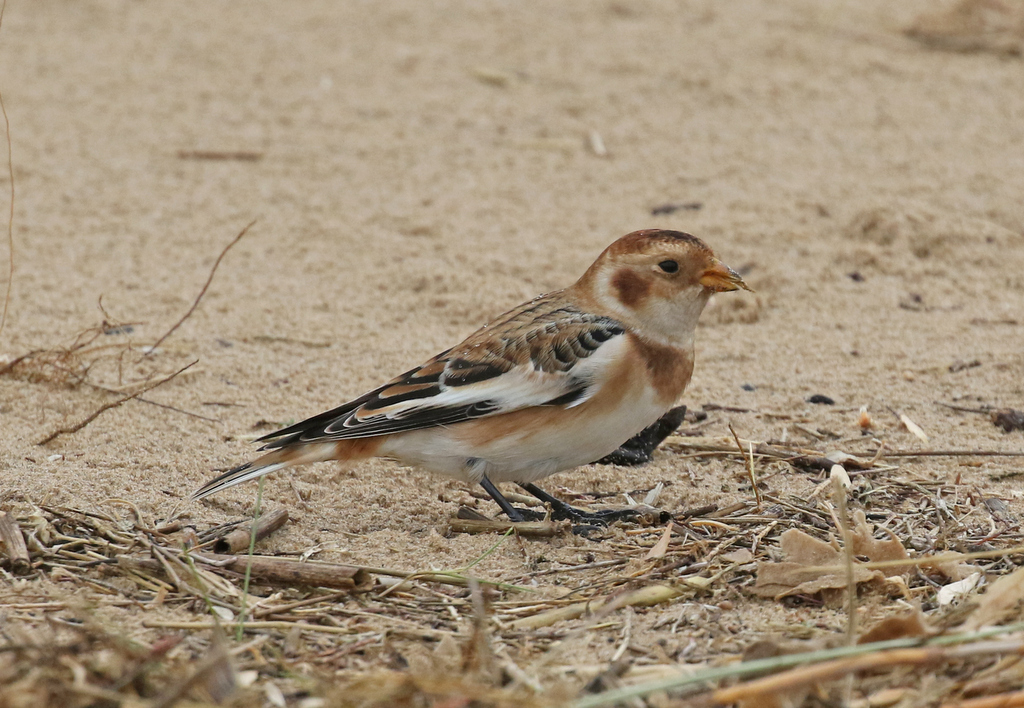
There were several small groups of waders on the shore all the way up. Groups of silvery-grey Sanderling running in and out of the waves like clockwork toys. We stood still and one ran straight past us. One or two Ringed Plovers were mixed in with them and several Turnstones were feeding higher up on the high tide line.

A couple of people coming back along the beach told us that a Lapland Bunting was still out on the beach Thornham Point, so we quickened our step. We wanted to get out there before it got disturbed. One person had already overtaken us, and more were coming out onto the beach behind. We bumped into the Snow Bunting again out at the Point – the same one we saw earlier, it must have flown past us with the Sanderlings.
As we walked round the Point, we thought we would find the person who had gone ahead of us watching the Lapland Bunting, but they had disappeared. We would only find out a couple of days later that they had flushed the Lapland Bunting and made a quick getaway before we arrived!
We walked slowly past the piles of debris on the high tide line, unaware that the bird had flown off, when suddenly something flicked up from behind a large pile of dead vegetation just in front of us. Thankfully it landed again a few feet ahead – the Lapland Bunting! It had obviously flown back after the other person had left.
We stood still and got the Lapland Bunting in the scope. It was almost too close, fill the frame views at minimum magnification! Like the Snow Bunting earlier, but even more so, it was totally unconcerned by our presence, busy feeding. It worked its way down to the end of the piles of debris and then came back right past us within only a couple of metres. We had it all to ourselves – we could see the hint of a rusty chestnut collar and its black bib. Stunning!
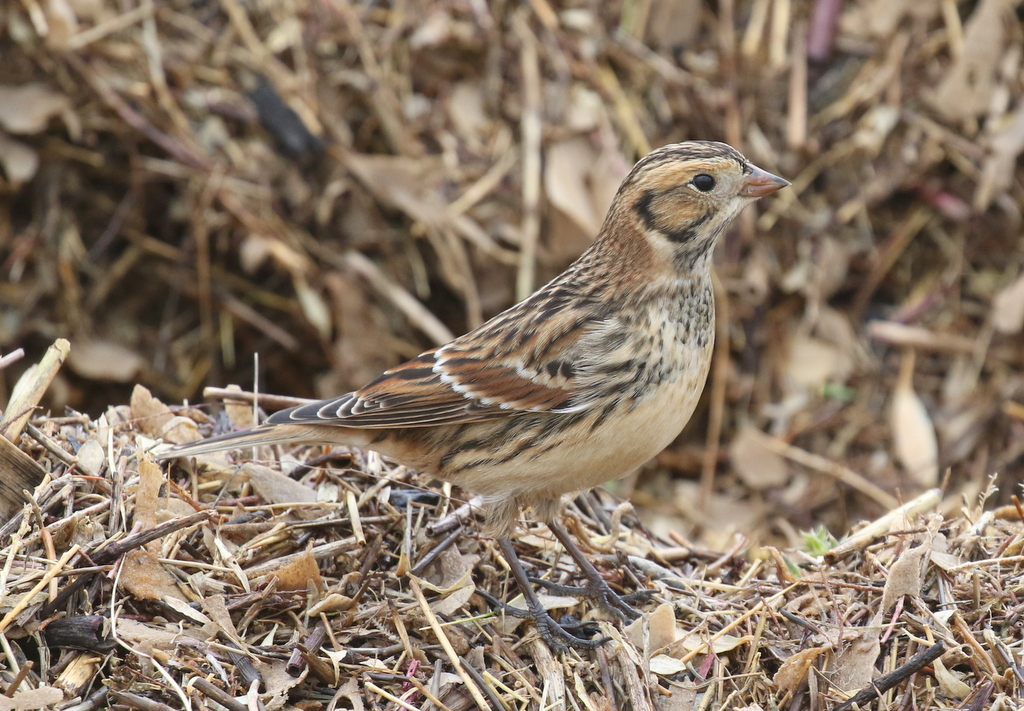
We had seen dark clouds away to the west earlier, and now it started to rain. We were rather exposed out on the beach, so we went to seek shelter round the other side of the Point. We thought we might get round to the tower, but the saltmarsh had flooded over the high tide and was impassable without boots. Thankfully the rain quickly stopped. A Great White Egret was out on the flooded saltmarsh in the middle of Thornham Harbour.
Back out on the beach, the Lapland Bunting was still feeding along the high tide line as we passed by. A couple of Sandwich Terns were fishing offshore. We had seen them flying up and down as we walked out and they were now diving into the water. Several Gannets were plunge diving off the Point too, including a couple of dark juveniles and white adults with black-tipped wings. As we started to walk back, we kept one eye on the sea and picked up an Arctic Skua flying past low over the water offshore. A nice bonus.
We had more great views of Sanderlings again on the walk back. When we got back to the main path, we stopped again for another quick look at the sea. Several Great Crested Grebes were out on the water and a single Red-throated Diver flew in and landed further out. We could see more shower clouds approaching, so we waited on the beach in the lee of the dunes. The worst of the rain passed to the east of us, and just the edge of the rain caught us and was thankfully over very quickly.
As we set off back along the main path, the waders were still roosting on the Tidal Pool. The Spotted Redshank was now in with the Common Redshanks, preening, giving us a good side by side comparison. Two Great White Egrets were now flying round together out over the saltmarsh.
Back at the Freshmarsh, the Bar-tailed Godwits were starting to fly out to the beach in groups, calling, ready to feed on the falling tide. A canteen of Spoonbills was roosting out in the middle now – we counted fourteen. They mostly asleep, as Spoonbills often do, but one was awake and feeding and a couple were preening. While we were standing here, one Spoonbill took off and flew right over our heads, heading out to the saltmarsh to feed.
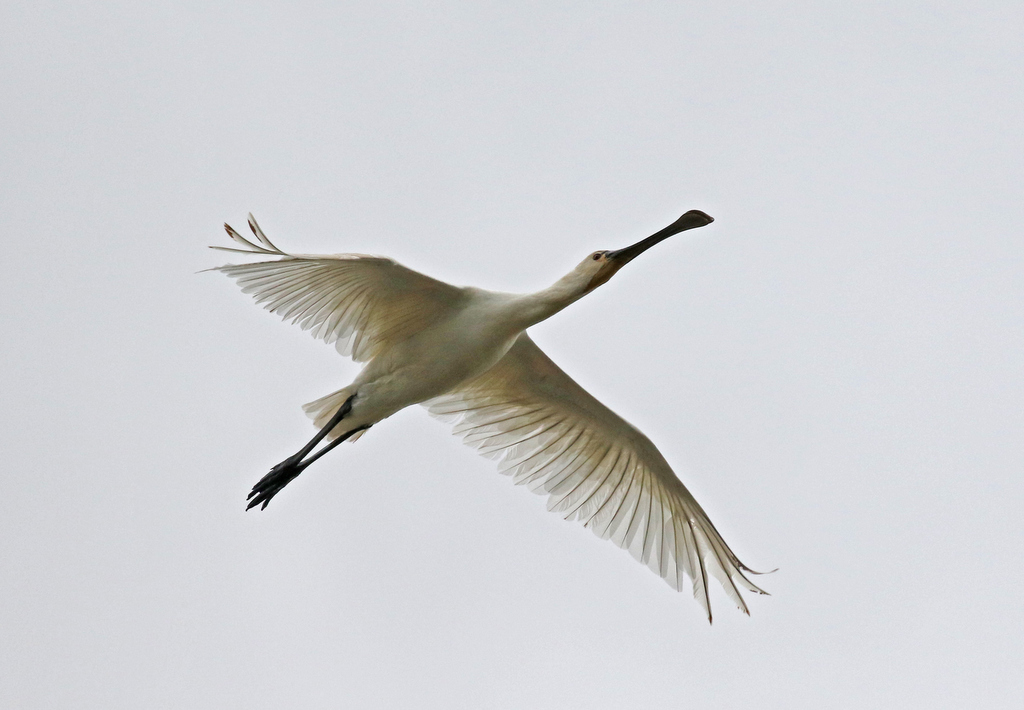
There were Bearded Tits calling from the reeds below the bank now, and a female climbed up into the top to feed on a seedhead. A Reed Warbler was flitting around in the reeds too. A careful scan round the reeds on the far side revealed a Water Rail feeding quietly on the edge of the mud.
We had a more careful look through the waders now. There were about ten Avocets still, and a few Ruff. Another Spotted Redshank called and we watched it fly across the bank close to us before heading out over the saltmarsh – a different bird to the one we had seen earlier, this time a dusky grey juvenile.
There was a group of smaller waders on the mud over by the reeds. A look through them reveled two slightly larger and longer-billed juvenile Curlew Sandpipers in with several streaky-bellied Dunlin. We had a good view of them through the scope. They were gradually working their way over close to Island Hide, so we thought we would go in for a closer view. But just at that moment a Kestrel flew in from the saltmarsh, dipped down low between Island Hide and the reeds and spooked them. They landed again but back further out.
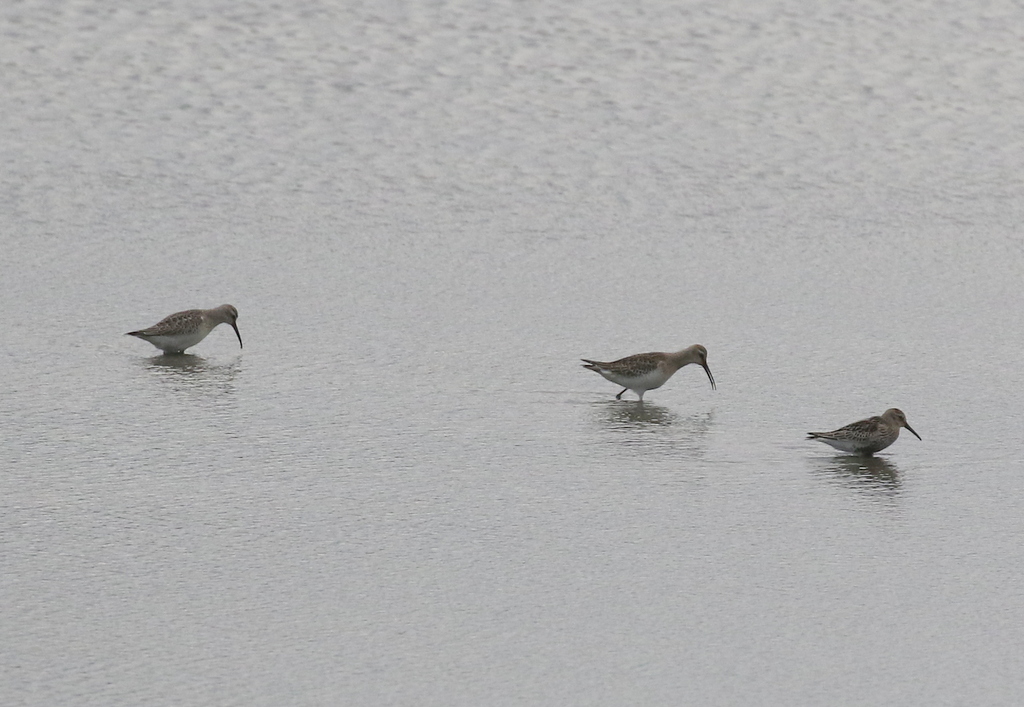
Looking across the reedbed, we could see two Hobbys now, hawking back and forth over the trees around Fen Hide. We walked back to the Visitors Centre, and decided to have a quick look at Patsy’s Reedbed and along the Autumn Trail before lunch, so turned out along Fen Trail.
A Coot was the highlight on Patsy’s, along with a couple more Common Pochard. Round on East Trail, we came across a flock of Long-tailed Tits on the edge of Willow Wood but again couldn’t find anything with them.
Continuing on down to the far end of Autumn Trail, we stopped to scan the back of the Freshmarsh. There didn’t appear to be much different here at first, but scanning across we noticed a 1st winter Mediterranean Gull in the middle of a long line of gulls on the water. Three nice juvenile Ruff were feeding on the edge of the reeds in front and there were more Bearded Tits here, calling and flying across over the reeds.
It was time to head back – we would already be having a late lunch now. One of the Hobbys was now hawking over the front of Willow Wood, but disappeared round the back and appeared to land out of view. We could see more dark clouds approaching and hoped we might get back before they arrived, but we had only made it as far as Fen Hide when it started to rain. We ducked in, and were very glad of the shelter and our timing because the heavens opened and there was a torrential downpour for about twenty minutes.
By the time it stopped and we could make our way back to the bus now it was definitely a late lunch! Afterwards we drove back east along the coast road to Wells and parked in the beach car park. As we walked in towards the Woods, at least ten Little Grebes were out on the boating lake.
In through birches and round under the trees on the north side of the Dell, it all seemed very quiet, and we couldn’t find any sign of a tit flock. Round at the Dell meadow, we met someone just leaving who told us that the Red-breasted Flycatcher was still around, but he hadn’t seen it. We cut in through trees where we had seen it the other day.
There were a few more people in here, under the trees, waiting for it to reappear and as we walked round the Red-breasted Flycatcher flicked across in front of us, up in the trees. We had a quick view of it from beneath, before it moved back further through the trees along the path. We knew it would be following its usual circuit, but someone there objected to us following it down the path, insisting we should wait for it to come back here. No problem. We walked out and round the long way to the other side.
There were a couple of more friendly locals here and we joined them on the bank. After a minute, the Red-breasted Flycatcher reappeared low down in the back of the trees, where we had watched it the other day. It was hard to see until it moved, but we could follow it as it flicked across to the next tree and everyone got onto it.
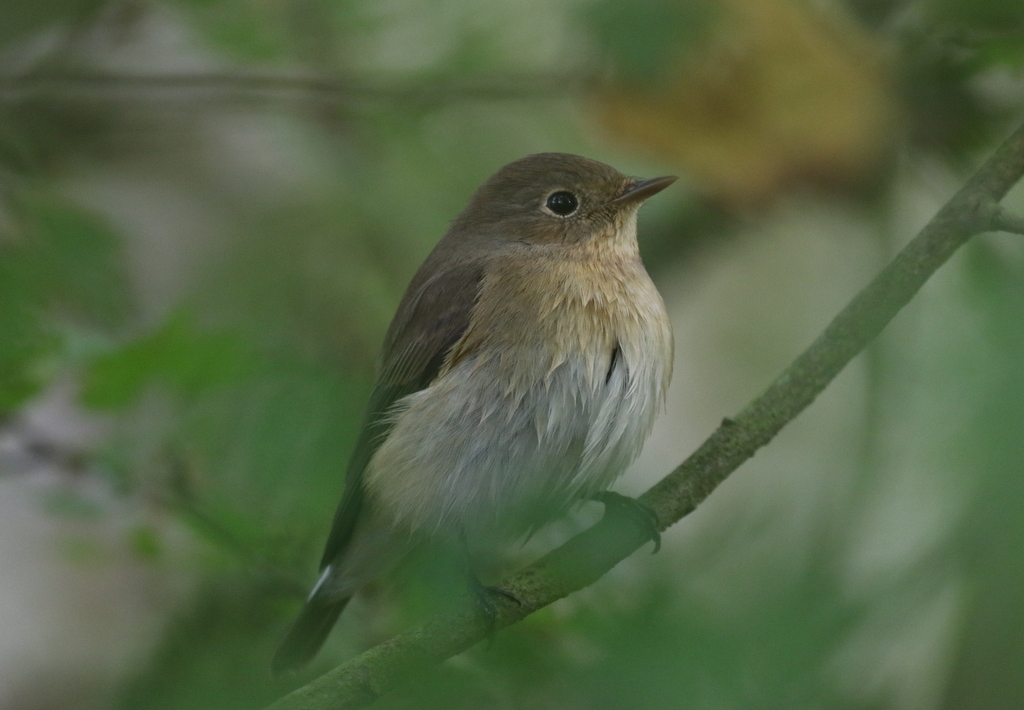
When it got to the trees above a small pool, the Red-breasted Flycatcher froze and stayed still. It was not feeding as actively and we soon realised why when it dropped down to the water to bathe. Afterwards it flew up into a nearby tangle to preen and dry itself. Great to watch.
It flicked up again and we lost sight of it in the back of the trees. Then we picked it up again, seemingly going back on its circuit, so we walked back round the long way to where we had first seen it today. The person who had told us we should wait here had given up and gone. We stood in the trees and the Red-breasted Flycatcher flew in and landed right in front of us, just a couple of metres away. Great views! We stood quietly and watched it, perching still in the trees before making little sallies after insects.
The Red-backed Shrike here was reported as still present too, but had moved a couple of fields from where we had found it the other day. As we walked down the track past the caravan site, a flock of Pink-footed Geese flew up off the grazing marshes and disappeared off inland.
When we got to the bales by the cattle field, we found a couple of people watching the Red-backed Shrike on the fence. We got it in the scope and had a good look at it, much better views than the one at Titchwell this morning. A two Red-backed Shrike day!
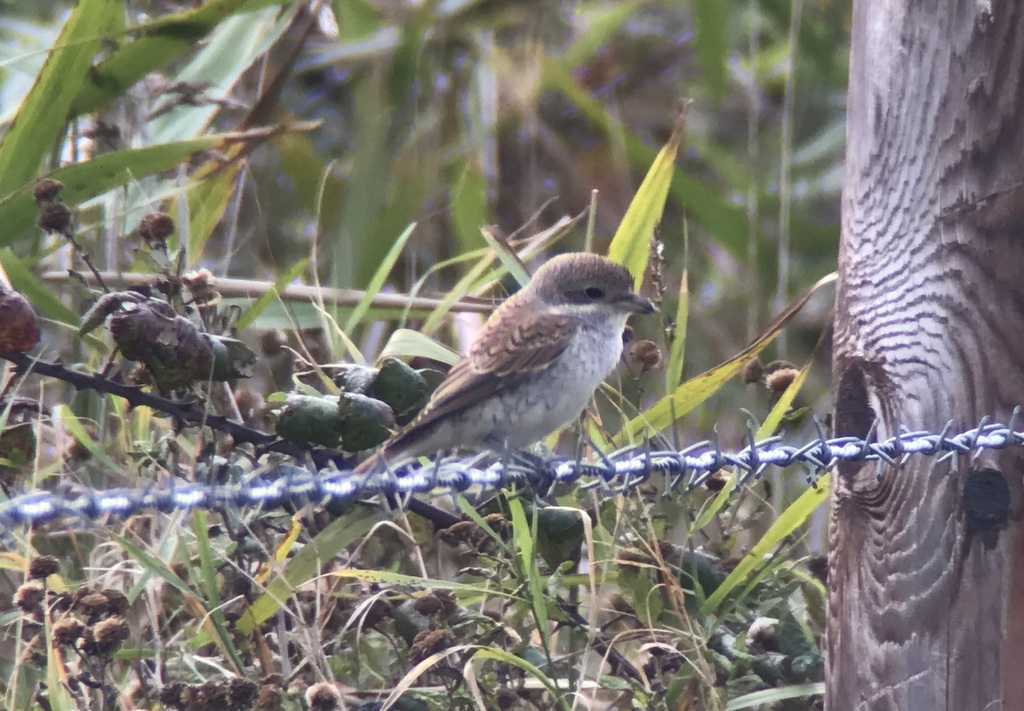
We could see some Pink-footed Geese down in the grass in the next field over. Several flocks flew up calling, their distinctive yelping calls the sound of the winter here, and we watched as they headed off inland. There were still some down in the grass, so we got them in the scope, admiring their dark head and delicate dark bills with a variable pink band around.
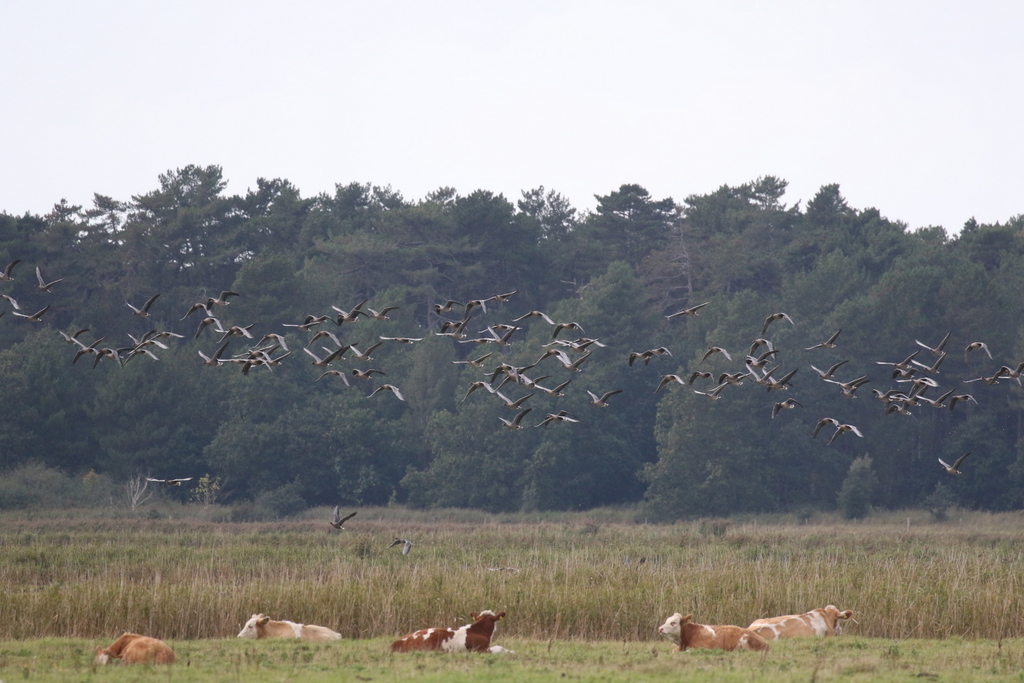
Unfortunately it was now time to head for home. It had been a great couple of days, with some really good birds, and not to forget the wonderful Wader Spectacular yesterday. Lots to live long in the memory.
















